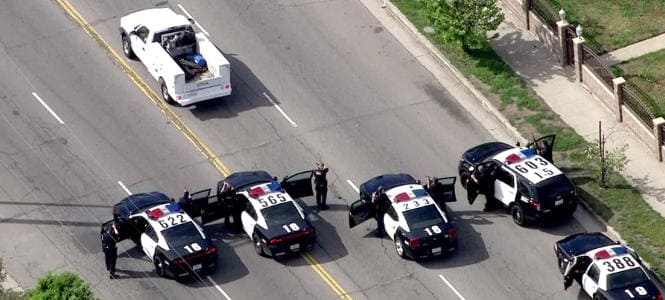

Police pursuits are seemingly as much of a part of the fabric of Southern California at this point as traffic, smog, and the way we all politely ignore celebrities as they buy cigarettes in front of us at 7-11 at two in the morning. Because these pursuits are an ever-present feature of KTLA 5 and K-CAL 9’s broadcast schedules, it is easy to forget what happens after the suspect is apprehended and the news helicopter’s fly back to cover the Staples Center or the next Santa Ana wind driven wildfire. Felony Reckless Evasion in California is a serious crime that carries along with it serious legal consequences.
This crime is covered under California’s Felony Reckless Evasion in California Vehicle Code 2800.2, but also incorporates Vehicle Code 2800.1:
VC 2800.1 covers the misdemeanor offense of simply evading a police officer while operating a motor vehicle. It is important to note that not everything counts as an “evasion” though under this code. If an individual can demonstrate that they did not intend to evade the law enforcement officer, then they are not guilty of the evasion.
Similarly, VC 2800.1 also requires the officers to behave in certain ways in order for the failure to stop to be considered an evasion. For instance, the pursuing officer’s vehicle must visibly show at least one lighted red light that is visible from the front of the officer’s vehicle, and, in addition, the individual has to either have seen it or should have seen it. Along these same lines, the officer’s vehicle needs to be sounding a siren as is reasonably necessary, be marked distinctively so as to be recognized as a police vehicle, and the vehicle must be operated by an officer who is wearing a distinctive uniform so as to be easily identified as a member of law enforcement. Given these common sense requirements, the Felony Reckless Evasion in California Vehicle Code is designed to prevent people from being able to impersonate an officer in order to have someone pulled over. By necessitating several indicia, knowledge plays an important role in this violation, as in many crimes. The person being pursued must have knowledge that they are evading a police officer and not simply driving away from someone intent on harassing them.
This now takes us to Felony Reckless Evasion in California VC 2800.2. An individual is found to be in violation of Felony Reckless Evasion in California VC 2800.2(a) under conditions where, “…a person flees or attempts to elude a pursuing peace officer in violation of VC 2800.1 and the pursued vehicle is driven in a willful or wanton disregard for the safety of persons or property.” The willful and wanton disregard for safety is the key feature in turning a misdemeanor evasion into a felony.
According to the jury instructions offered for evaluating this type of crime, someone commits an act willfully when they do it “willingly or on purpose”. However, nowhere included in this is the requirement that the individual had any intention of breaking the law or hurting anyone. It is sufficient to qualify as a willful act if the act itself is deemed to have been done with intent. The repercussions of said act do not have to be willful. In this instance then, the act of evading a police officer in a vehicle is enough to satisfy this requirement. Any subsequent damaged caused by the evasion, such as damage to vehicles or other property, or hitting and injuring people during an individual’s fleeing, need not be intentional. This would still qualify and satisfy the willfulness prong.
Next, when looking at the wanton disregard for safety element, the California jury instructions note that an individual is deemed to have acted with wanton disregard for safety if they are aware that their actions present a substantial and unjustifiable risk of harm and if the individual then ignores this risk. It is this knowledge of and then disregard of the risk of harm that makes an act wanton. This does not mean that the individual had to have intended to cause any specific damage though, per se. Like with the willful requirement, specific knowledge of or intention to cause harm is not required, only the lack of proper regard for the safety of those around the individual.
Outside of these definitions and legal requirements, it is also important to keep in mind that another way to run afoul of the willful and wanton disregard for safety elements is to commit three different traffic violations in the course of the evasion that would qualify an individual to receive a “point” under the California Felony Reckless Evasion in California Vehicle Code. The DMV website contains a running list of all of the possible moving violations that can earn one a point.
For the most part, this list contains well-known driving infractions like speeding in excess of the limit, drinking while driving, and running a red light. However, the extensive list also contains little-known infractions like use of the two-way left turn lane, improper lane use, and following too closely. What this means then, is even if someone is driving relatively safely while evading an officer, if they commit three of these driving infractions in the course of the evasion, this will qualify them for driving with a willful and wanton disregard.
Felony Reckless Evasion in California is what is known as a “wobbler” offense in California, meaning that it can be knocked down to a misdemeanor charge potentially depending on the individual’s criminal history (if any) and the circumstances surrounding the crime. Depending on whether or not this happens, reckless evasion in California can carry different penalties as a result.
Looking first at reckless evasion in California, if it remains a felony, this crime can carry with it a prison sentence of 16 months, two years, or three years in state prison. In addition, the individual can also be charged with a fine of up to $10,000.
If, however, the reckless evasion in California can be knocked down to a misdemeanor, then the penalties drop to at least six months to one year in county jail, with an additional fine of up to $1,000 possible as well. While this is a significantly reduced sentence compared to the felony offense, it is still a rather hefty penalty.
While felony reckless evasion in California is a serious crime that carries with it stiff penalties, there are some legal defenses that can be brought to bear on behalf of an individual charged as such. Like with many crimes, if not most, intent plays a large role in the crime of reckless evasion in California. In order to be found guilty of such, an individual must have intended to evade a police officer. While this seems cut and dry, that an individual either intended to evade the police or they didn’t, this is not always how it plays out in the real world.
For example, plain clothes officers can be found throughout numerous big cities. In fact, a higher than average amount of police-involved deaths of civilians involves plainclothes officers. Often, these officers attempt to engage with an individual as if they were clearly identified as a member of law enforcement despite the fact that there is nothing about them that makes this plain to the civilian. As such, if an individual flees from someone in plainclothes brandishing a firearm only to later discover they were in fact law enforcement, this would not qualify as reckless evasion in California. Because the individual did not know they were fleeing from an officer, they do not have the requisite mental state and intention to be found guilty.
This is also bolstered by the very language of VC 2800.1 and its incorporation into Felony Reckless Evasion in California VC 2800.2. Because the vehicle code lays out that the officer must be properly identified as such, with at least one lighted red lamp, siren, distinctive marks, etc., if these identifying criteria are not present, an individual cannot be found guilty of reckless evasion since they were unaware that they were fleeing from an officer of the law.
Another possible defense to the crime of reckless evasion in California is that the evasion began after an illegal stop. If the stop, or attempted stop, resulted from an unjustified reason by the officer, for example racial profiling, then any evasion resulting from this stop could be defended against on these grounds. If the initial attempt to stop the individual was based on an illegal premise, racial or not, then any evasion of such could potentially cease to be a crime. Living in an age of police brutality and violence disproportionately directed at ethnic minorities, it is not a large stretch to understand why a person of color would be hesitant to stop when asked to by an officer. This fear could lead the individual to drive away or disregard the officer’s instructions because they fear for their safety and their life. If the premise of the stop, to begin with, was illegal and based on said racial profiling, then this could potentially serve as another defense.
If you or a loved one has been charged with a violation of Felony Reckless Evasion in California VC 2800.2 felony reckless evasion in the California area, we invite you to contact us immediately for a free case review. Our experienced and assiduous Criminal Defense Lawyers will be sure to fight until the end to reduce or drop your charges completely.
Call LAW MART for a FREE Case Review: 310-894-6440

Copyright © 2024 law – Powered by AmelCS